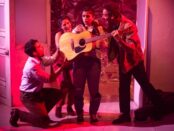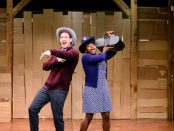Travels
"Travels" at Ars Nova isn’t just a story of the many places James Harrison Monaco has been. That’s part of it, the most superficial part. "Travels" is far more: a deep look at the people in his life, two in particular, whose fascinating and moving stories emerge from a torrent of music, videos, lights and words. In eight songs/scenes a very personal saga unravels until a chilling coda. On the tiny Ars Nova stage, a console contains the control center of the production. Constantly moving images give the illusion of flying into a vortex, soon replaced by more informative images that illustrate the stories told by Monaco and his very talented compatriots: El Beh, Ashley De La Rosa, Mehry Eslaminia and John Murchison. [more]






